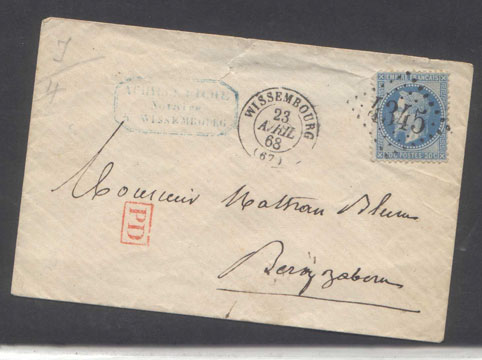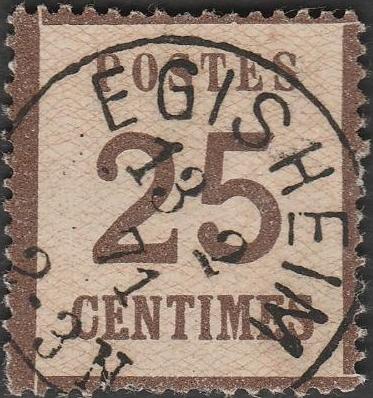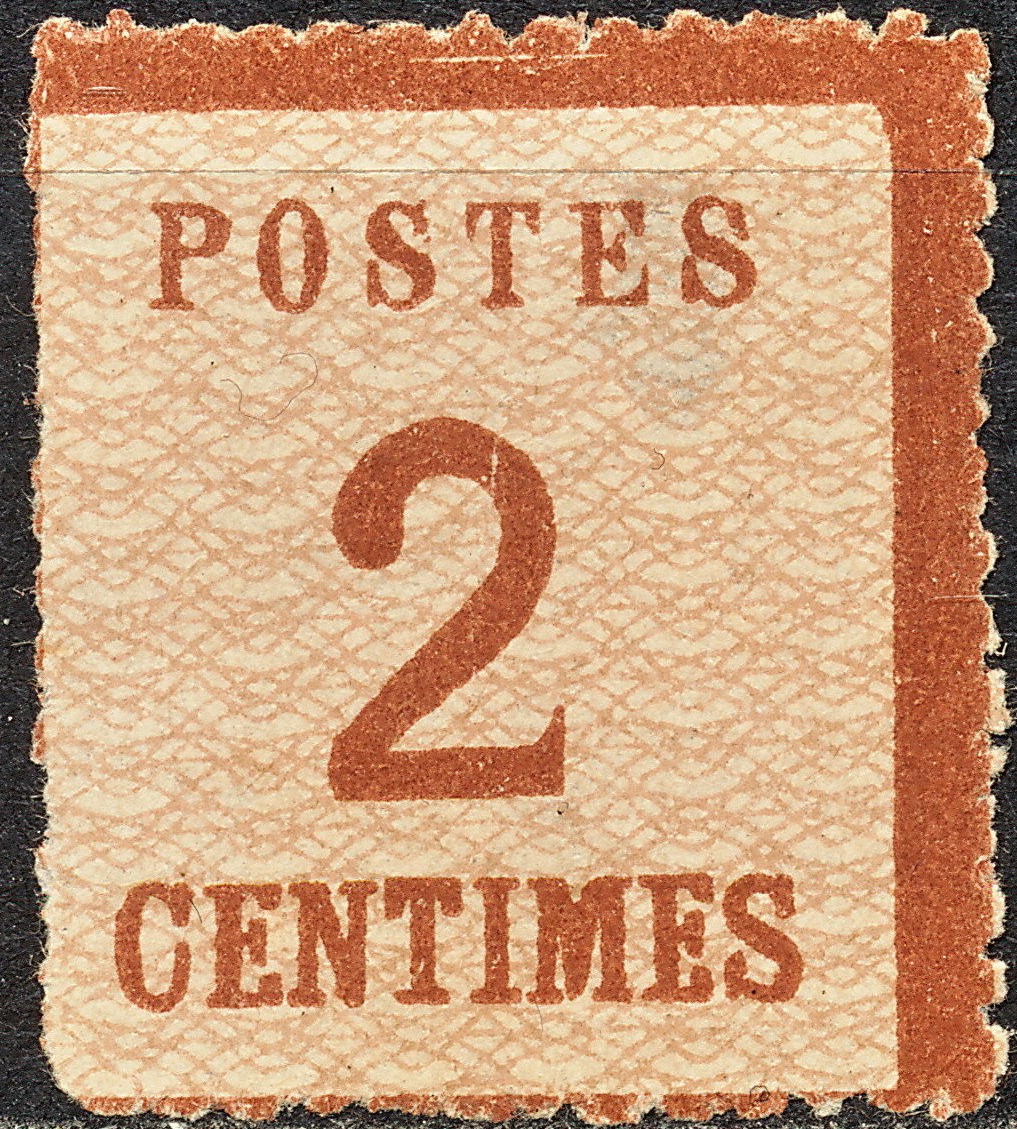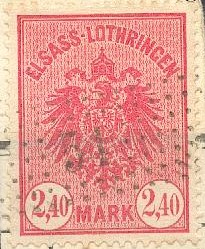 |
|||||
|
|||||
| Preview of Stamps Catalogue: VOLUME 1 |
 |
|||||
|
|||||
| Preview of Stamps Catalogue: VOLUME 1 |
Elsass-Lothringen
Note: on my website many of the
pictures can not be seen! They are of course present in the catalogue;
contact me if you want to purchase it.
Alsace and Lorraine were occupied by the Germans in the French- German war of 1870-1871. Some stamps with inscription "POSTES", the value and "CENTIMES" were issued. For political reasons no country name was indicated. Be aware: many forgeries and reprints exist! Before 1870 French stamps were issue, later German stamps were used, examples:

('4345' large french numeral cancel 'Wissembourg' on cover with
french 20 c Napoleon stamp, 1868)

(So called 'Hufeisenstempel' or Horseshoe cancel of Strassburg on
two stamps of Germany)

(Strassburg Elsass Ruprechtsau cancel on a normal German stamp,
1898)
1 Centimes green 2 Centimes brown 4 Centimes grey 5 Centimes green 10 Centimes brown 20 Centimes blue 25 Centimes brown
For the specialist: there are two ways the wavy background lines are printed on the stamps, one with the lines pointing upwards and on with the lines pointing downwards.


(Front and backside of the 5 c stamp)
Value of the stamps |
|||
vc = very common c = common * = not so common ** = uncommon |
*** = very uncommon R = rare RR = very rare RRR = extremely rare |
||
| Value | Unused | Used | Remarks |
Wavy background pointing upwards |
|||
| 1 c | *** | *** | |
| 2 c | *** | *** | |
| 4 c | *** | *** | |
| 5 c | *** | *** | |
| 10 c | *** | * | |
| 20 c | *** | ** | |
| 25 c | R | *** | |
Wavy background pointing downwards |
|||
| 1 c | RR | RR | |
| 2 c | RR | RR | |
| 4 c | R | R | |
| 5 c | RRR | RRR | |
| 10 c | R | ** | |
| 20 c | RR | R | |
| 25 c | RRR | RRR | |
Reprints |
|||
| All values | * | * | |
When the war ended, the use of these stamps was stopped in the occupied territories on 24 March 1871, but they continued to be used upto 31 December 1871 in Alsace and Lorraine.


Special fieldpost cancel "K:PR:FELDPOST RELAIS" in a
rectangle.

"K.PR. FELDPOSTRELAIS" in a circle.
These reprints were made with the original background pattern, however the text was newly made. They were ordered in Hamburg in 1885(?) with the original background pattern. Reprints can be recognized by the position of the "P" of "POSTES", if we draw a line connecting the upper left corner of the containing rectangle to the lower right corner, the line should go through the bottom part of the "P". However, in the reprints it will go through just below the center of the "P".

(Reprint with a forged cancel?)
The Fournier forgeries exist with forged cancels. One forged cancel on these forgeries is known to be easily detectable: "Urbeis 31 2 71 2-3N", this can never be a genuine cancel, since February never has 31 days! (I have never seen this date on his forgeries myself). The perforation in the corners is not perfect in the Fournier forgeries. Furthermore, according to 'The Forged Stamps of all Countries' by J.Dorn, the wavy background patterns are not as parallel as in the genuine stamps and the patterns they form are also slightly different.
Fournier took great pride in his forgery of the 4-centime stamp of Alsace and Lorraine, the variety with figure displaced to the left, and vertical bar at the top of the T of "centimes." He himself considered it to be one of his 'masterpieces' (this text is translated from Serranne, in the french introduction of 'The Fournier album of philatelic forgeries').
The following cancels can be found in 'The Fournier album of philatelic forgeries'. According to the Serrane guide these cancels had interchangeable date.


(Reduced sizes)
The following cancels can also be found in this album, but I think they were used on telegraphic stamps of France instead (the date is 1869!):

Reduced sizes






Fournier forgeries of the 25 c value with "GEISPOLDSHEIM
11/1 71 4-5 N.", and 4 c and 25 c forgeries with
"EGISHEIM" cancels as shown above. Also a 4 c with a
forged "URBEIS 31 2 71 2-3N" cancel (an impossible
date, since February never has 31 days....).


Two Fournier forgeries with "BOLCHEN 20 6 71 4-5N"
cancel.

Fournier forgery of the 10 c value with "K.PR. FELDPOST -
RELAIS No 19 3 1 1"

Fournier forgery with "POSTES * EPINAL *" cancel

1 c Fournier forgery with "URBEIS 1 2 71 2-3N" cancel.

Another page from a Fournier Album.

(Hialeah forgeries, reduced size)
The above forgeries are made with a scanner and printer. The printing is very badly done (as the perforation). I've also seen the value 1 c of this particular forgery.


(Mystery stamp, 10 c, no underprint and no "CENTIMES",
forgery?)
Furthermore so-called Paris forgeries and Brussels forgeries exist (sorry, no images available yet), both with perforations 13 1/2 instead of 13 1/2 x 14 according to 'Germany and it Colonies' by Bertram W.H.Poole. These two forgeries are also mentioned in 'The London Philatelist' 5 1896, p.61 'Manchester Philatelic Society' news by Vernon Roberts. According to the Barefoot guide, the Paris and Brussels forgeries are actually the same forgeries.

Could this be one of those forgeries?



These stamps look very suspicious to me, they might be Paris
forgeries?
Reichseisenb. in ElsaB-Lothringen

(Reduced size)
I have seen the following values: 5 p red, 30 p green, 40 p orange, 50 p lilac, 60 p blue, 70 p lilac and 90 p brown. I think these stamps are not very common.

3 p brown 4 p blue 5 p green 6 p dark green 8 p orange 10 p brown 12 p red 15 p brown (maroon) 20 p blue 25 p blue 30 p olive 40 p violet 50 p green and black 60 p lilac and black 80 p blue and black 100 p orange and black
3 p brown 4 p blue 5 p green 6 p dark green 8 p orange 10 p brown 12 p red 15 p brown (maroon) 20 p blue 25 p blue 30 p olive 40 p violet 50 p green and black 60 p lilac and black 80 p blue and black 100 p orange and black
Some fiscal stamps were issued in Alsace, after the German occupation of 1870.

20 c violet, 50 c brown, 1 F green, 1F50 brown, 2 F blue and 3 F red.


(Left: large arms in center with some feathers upwards; right:
small arms with all feathers downwards)
16 pf violet, 20 p grey, 40 pf brown, 80 pf green, 1.20 M brown, 1.60 M blue and 2.40 M red. Two slightly different designs seem to exist for all values (except 20 p, for examples see above).
The following values were issued in 1888: 10 p red, 20 p blue, 40 p brown, 50 p brown, and 80 p grey. In 1896 similar stamps (but slightly smaller) were issued in the values: 5 p green, 10 p red, 20 p blue, 40 p violet, 50 p brown and 80 p violet.

The following values were issued: 5 p, 10 p, 20 p, 30 p, 40 p, 50 p, 60 p, 80 p (all in red), 1 M, 1.50 M, 2 M, 3 M, 4 M, 5 M, 6 M, 7 M, 8 M, 9 M and 10 M (all in blue). The value is printed in black.
The following values were issued: with inscription 'TEILBETRAG': 2.50 M red, 4 M, 6 M blue and 7.50 M brown; with inscription 'JAHRESBETRAG': 5 M red, 8 M, 12 M blue and 15 M brown.
Other series exist. Example:

Arms, inscription 'STEMPELMARKE ELSASS LOTHRINGEN', reduced size
Stamps - Timbres-Poste - Briefmarken